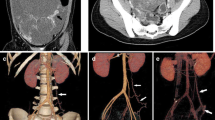Abstract
Computed tomograms of 68 adult women who had undergone contrast-enhanced, 5-mm helical computed tomography of the abdomen and pelvis were retrospectively reviewed to determine whether the ovarian vein could be used to locate the ovary. Subjects were 17 to 84 years of age (mean 45 years); 31 scans were normal, and 37 showed pelvic masses. Both ovarian veins were identified at their termination and were followed into the pelvis by scrolling through the set of venous phase images with a manual cine-paging tool. All 68 left ovarian veins and 67 of 68 right ovarian veins were identified. All visualized ovarian veins led to a normal ovary or to an ovarian mass. There were no anatomic variations. In 13 ovaries displaced by pathology in the pelvis, the ovarian vein was correspondingly displaced and indicated the altered ovarian position. In all 14 patients with non-ovarian pelvic masses, ovarian veins led to the normal ovary; the vein and ovary were markedly displaced in three of these patients. On computed tomography, the ovarian vein can be consistently identified. By tracing the vein into the pelvis, the ovarian or non-ovarian nature of a pelvic mass can be determined.




Similar content being viewed by others
References
Langer JE, Jacobs JE. (1996) High-resolution computed tomography of the female pelvis: spectrum of normal appearances. Semin Roentenol 31:267–278
Rozenblit AM, Ricci ZJ, Tuvia J, Amis ES Jr. (2001) Incompetent and dilated ovarian veins: a common CT finding in asymptomatic parous women. AJR 176:119–122
Lee JH, Jeong YK, Park JK, Hwang JC. (2003) “Ovarian vascular pedicle” sign revealing organ of origin of a pelvic mass lesion on helical CT. AJR 181:131–137
Sasouk FA, Johnson SC. (2004) Recognition of the ovaries and ovarian origin of pelvic masses with CT. Radiographics 24(suppl 1):S133–S146
Angiology. In: Williams PL, Warwick R, eds. Gray’s anatomy. Edinburg: Churchill Livingstone, 1980:622–784
Yassa NA, Ryst E. (1999) Ovarian vein thrombosis: a common incidental finding in patients who have undergone total abdominal hysterectomy and bilateral salpingo-oophorectomy with retroperitoneal lymph node dissection. AJR 172:45–47
Diamond AB, Meng C-H, Kodroff M, Goldman SM. (1977) Testicular venography in the nonpalpable testis. AJR 129:71–75
Dickey KW, Glickman MG, Bookstein JJ. Angiography of the genitourinary tract: techniques and applications. In: Pollack HM, McClennan BL, eds. Clinical urography, 2nd ed. Philadelphia: WB Saunders, 2000:555–601
Author information
Authors and Affiliations
Corresponding author
Rights and permissions
About this article
Cite this article
Govil, S., Justus, A. Using the ovarian vein to find the ovary. Abdom Imaging 31, 747–750 (2006). https://doi.org/10.1007/s00261-005-0268-x
Received:
Accepted:
Published:
Issue Date:
DOI: https://doi.org/10.1007/s00261-005-0268-x




